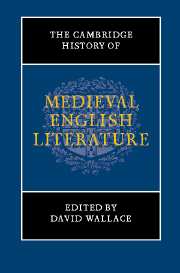Book contents
- Frontmatter
- I AFTER THE NORMAN CONQUEST
- II WRITING IN THE BRITISH ISLES
- III INSTITUTIONAL PRODUCTION
- Introduction
- 12 Monastic productions
- 13 The friars and medieval English literature
- 14 Classroom and confession
- 15 Medieval literature and law
- 16 Vox populi and the literature of 1381
- 17 Englishing the Bible, 1066–1549
- IV AFTER THE BLACK DEATH
- V BEFORE THE REFORMATION
- Chronological outline of historical events and texts in Britain, 1050–1550
- Bibliography
- Index of manuscripts
- Index
- References
14 - Classroom and confession
from III - INSTITUTIONAL PRODUCTION
Published online by Cambridge University Press: 28 March 2008
- Frontmatter
- I AFTER THE NORMAN CONQUEST
- II WRITING IN THE BRITISH ISLES
- III INSTITUTIONAL PRODUCTION
- Introduction
- 12 Monastic productions
- 13 The friars and medieval English literature
- 14 Classroom and confession
- 15 Medieval literature and law
- 16 Vox populi and the literature of 1381
- 17 Englishing the Bible, 1066–1549
- IV AFTER THE BLACK DEATH
- V BEFORE THE REFORMATION
- Chronological outline of historical events and texts in Britain, 1050–1550
- Bibliography
- Index of manuscripts
- Index
- References
Summary
Introduction
The thirteenth century, a period that sees the growth of schools, also sees the growth of the confessional system. These two developments are not unrelated: the legislation of the Fourth Lateran Council of 1215 making annual confession to one’s own parish priest universal and compulsory also renewed the call of the Third Lateran Council of 1179 for establishment of more schools and masters at cathedrals and churches to provide comprehensive pastoral training for secular clergy. The early years of the thirteenth century also saw the creation of the Franciscan and Dominican orders, which, along with the later mendicant orders, had a powerful impact on the proliferation of both educational and confessional texts. Both on historical grounds and in cultural terms, pedagogical texts and classroom practices have their natural counterparts in confessional texts and practices; our purpose here will be to consider the overlap and mutual resonance of the two traditions. The most obvious historical evidence of this connection is the practical assimilation of penitential texts into school texts, beginning in the thirteenth century and continuing into later centuries with much overlapping of classroom and confessional genres in the vernacular. In cultural and behavioural terms, classroom and confession are linked through the idea of disciplina, the regulation of knowledge and the regulation of the self, whether through the rigours of the classroom or of penitential practice. In both, the experience of the learner is individualized, yet streamlined according to time-honoured practices originating in antiquity.
- Type
- Chapter
- Information
- The Cambridge History of Medieval English Literature , pp. 376 - 406Publisher: Cambridge University PressPrint publication year: 1999
References
- 13
- Cited by

